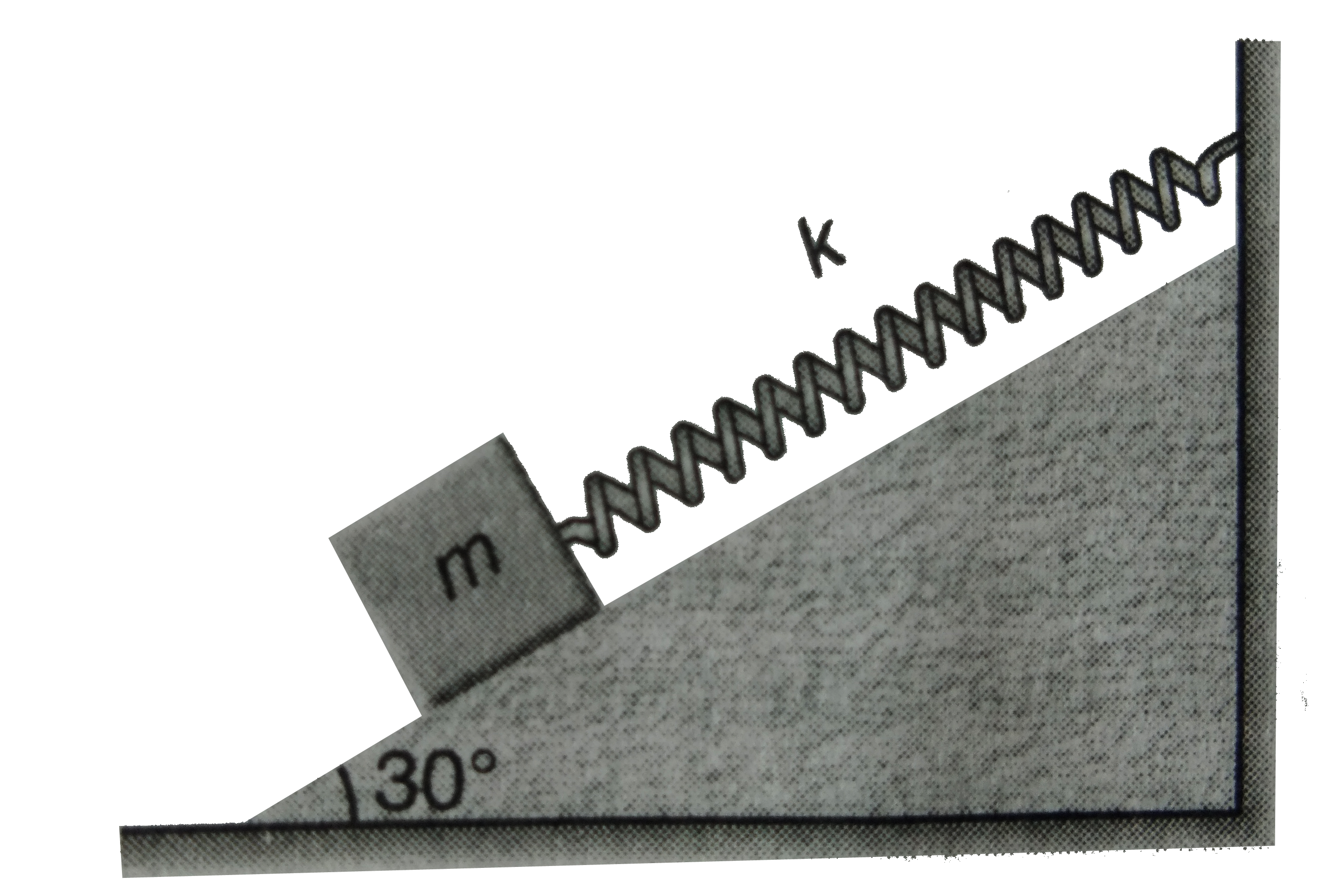A mass of 0.2 kg is attached to the lower end of a massless spring of force constant 200 N m−1 , the upper end of which is fixed to a rigid support. Which of the following statement is not true? (Take g=10ms−2)
The frequency of oscillation will be nearly 5 Hz.
In equilibrium, the spring will be stretched by 2 cm.
If the mass is raised till the spring is in unstretched state and then released, it will go down by 2 cm before moving upward.
If the system is taken to a planet, the frequency of oscillation will be the same as on the earth.
The correct Answer is:B
Frequency of spring , υ=12π√km
=12π√2000.2= 5 Hz.
In equilibrium , kx = mg
or x=mgk=0.2×10200=0.01 m
When mass is raised till the spring is unstretched, the work
=12kx2=mgx
When the mass is released from the unstretched position of spring, then total work done
mgx.=(mgx)+12kx2=2mgx
or x.=2x=2 x 0.1 = 0.02 m
As υ of spring is independent of g so that the frequency of oscillation will be the same as that on the earth.
Topper's Solved these Questions
- MODEL TEST PAPER 1 BOOK - MTG-WBJEECHAPTER - MODEL TEST PAPER 1 EXERCISE - PHYSICS (Category) 3 : Single Option correct type (2 mark)
5 Videos
- MOTION OF CENTRE OF MASS, CONNECTED SYSTEMS, FRICTIONBOOK - MTG-WBJEECHAPTER - MOTION OF CENTRE OF MASS, CONNECTED SYSTEMS, FRICTIONEXERCISE - WB-JEE Previous years questions
17 Videos
Similar Questions
A mass of 0.2 kg is attached to the lower end of a massless spring of force constant 200Nm the other end of which is fixed to a rigid support. Study the following statements.
View SolutionA mass of 0.2 hg is attached to the lower end of a massles spring of force constant 200Nm the opper end of which is fixed to a rigid support. Study the following statements.
View Solution
Knowledge Check
A mass of 0.2kg is attached to the lower end of a massless spring of force-constant 200N/m, the upper end of which is fixed to a rigid support. Which of the following statements is/are true?
AIn equilibrium, the spring will be stretched by 1cm.BIf the mass is raised till the spring is unstreched state and then released, it will godown by 2cm before moving upwards.CThe frequency of oscillation will be nearly 5Hz.DIf the system is taken to the moon, the frequency of oscillation will be the same as on the earth.A mass of 0.2 hg is attached to the lower end of a massles spring of force constant 200Nm the opper end of which is fixed to a rigid support. Study the following statements.
AIn equilibrium the spring will be stretched by 1 cm.BIf the mass is raised till the spring becomes unstretched and then released, it will go down by 2 2cm before moving upwards.CThe frequency of oscillation will be nearly 5 Hz.DIf the system is taken to the moon, the frequency of oscillation will be the same as that on the earth.A block of mass 1 kg is attached to one end of a spring of force constant k = 20 N/m. The other end of the spring is attached to a fixed rigid support. This spring block system is made to oscillate on a rough horizontal surface (μ=0.04). The initial displacement of the block from the equilibrium position is a = 30 cm. How many times the block passes from the mean position before coming to rest ? (g=10m/s2)
A11B7C6D15
A block of mass 1 kg is attached to one end of a spring of force constant k = 20 N/m. The other end of the spring is attached to a fixed rigid support. This spring block system is made to oscillate on a rough horizontal surface (μ=0.04). The initial displacement of the block from the equilibrium position is a = 30 cm. How many times the block passes from the mean position before coming to rest ? (g=10m/s2)
View SolutionA ball of mass m is attached to the lower end of a light vertical spring of force constant K. The upper end of the spring is fixed. The ball is released from rest with the spring at its normal ( unstretched ) length, and comed to rest again after descending through a distance x.
View SolutionA mass m is attached to the free end of a massless spring of spring constant k with its other end fixed to a rigid support as shown in figure. Find out the time period of the mass, if it is displaced slightly by an amount x downward.

View SolutionA block of mass 0.2 kg is attached to a mass less spring of force constant 80 N/m as shown in figure. Find the period of oscillation. Take g=10m/s2. Neglect friction

View SolutionA ball of mass m is attached to the lower end of a light vertical spring of force constant K. The upper end of the spring is fixed. The ball is released from rest with the spring at its normal ( unstretched ) length, and comed to rest again after descending through a distance x.
View Solution
